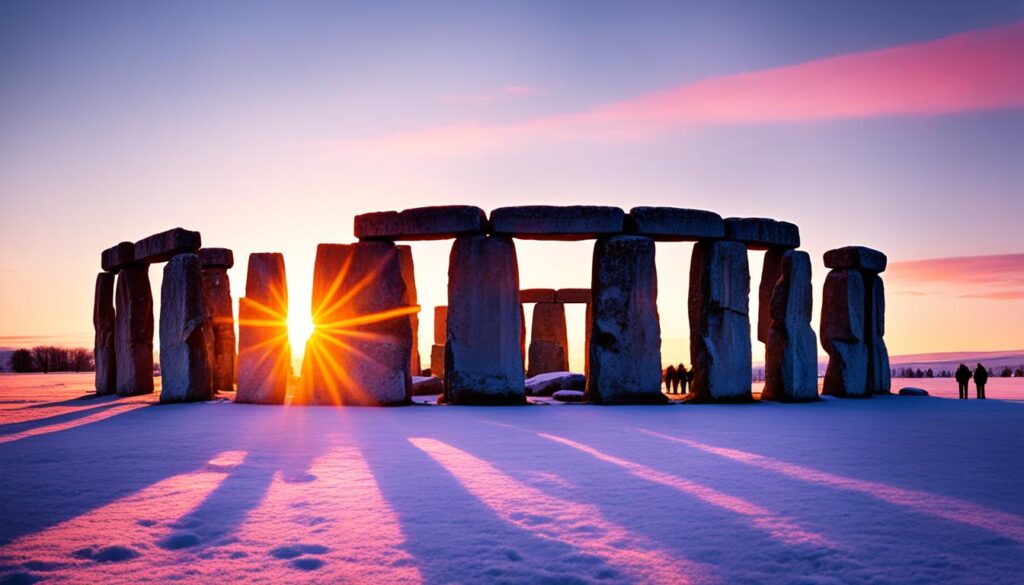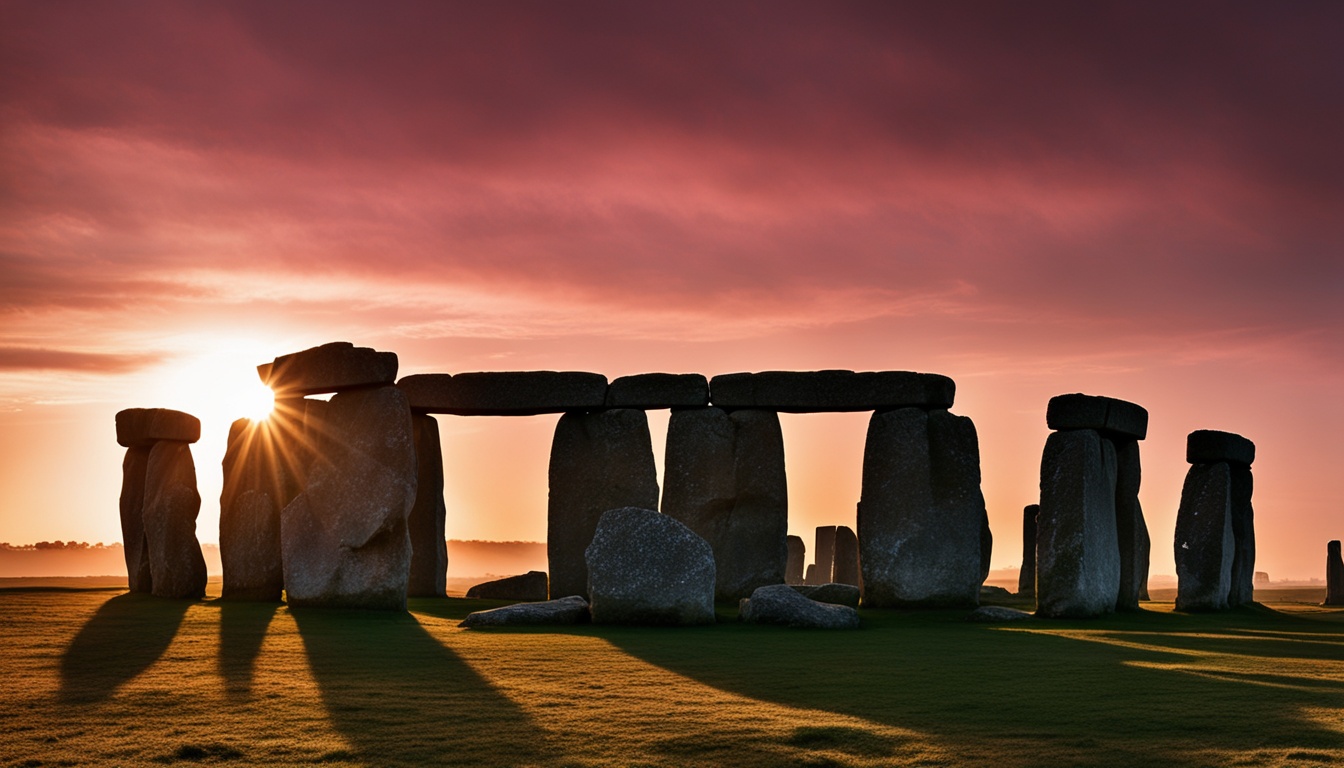Stonehenge, the iconic prehistoric monument in England, has captivated people for millennia with its ancient mystery. One of the most remarkable aspects of this stone circle is its precise alignment with the winter solstice sunset. Every year around December 21st, the shortest day of the year, the setting sun perfectly aligns with the central trilithon at Stonehenge, casting an ethereal glow across the ancient stones.
The winter solstice held great significance for the Neolithic people who built Stonehenge over 4,000 years ago. This astronomical event marked the transition from the darkest time of the year to the gradual return of the sun’s light and warmth. The precise alignment of Stonehenge with the solstice sunset is a testament to the sophisticated understanding of the cosmos possessed by these ancient builders.
Key Takeaways
- Stonehenge is precisely aligned with the winter solstice sunset
- The winter solstice occurs around December 21st each year
- Ancient people who built Stonehenge had advanced astronomical knowledge
- The winter solstice marked the transition from darkness to light
- Stonehenge’s solstice alignment is an enduring mystery and marvel
The Significance of the Winter Solstice at Stonehenge
For the ancient Neolithic people who built and used Stonehenge, the winter solstice held great significance. This pivotal moment in the yearly cycle marked the shortest day and longest night, a time that may have been filled with both fear and anticipation for these early farmers. As the days grew colder and shorter, they likely wondered if the sun would ever return to its former strength.
To mark this important event and perhaps to celebrate the eventual return of light and warmth, the Neolithic people gathered at Stonehenge for feasts, ceremonies, and celebrations. Archaeological evidence from nearby Durrington Walls suggests that massive feasts were held around the time of the winter solstice. Excavations at the site have revealed large quantities of discarded pig and cattle bones, indicating that these animals were slaughtered when they were around nine months old, which would have been during the winter months.

The winter solstice may have been a time of uncertainty for these ancient cultures, but it was also a time of hope and renewal. By aligning Stonehenge with the setting sun on the winter solstice, they created a powerful symbol of the cyclical nature of life and the promise of brighter days ahead. The feasts and ceremonies held at this time were not just a celebration of the solstice itself, but a reaffirmation of their connection to the natural world and their place within it.
Today, thousands of people continue to gather at Stonehenge to witness the winter solstice sunset, carrying on a tradition that stretches back thousands of years. While we may never know the full significance of this event to the monument’s Neolithic builders, we can still appreciate the enduring power and mystery of this ancient site and its connection to the ever-turning cycles of the sun and the seasons.
Stonehenge’s Winter Solstice Alignment
The ancient monument of Stonehenge, located in Wiltshire, England, has long been shrouded in mystery and wonder. One of the most fascinating aspects of this prehistoric site is its alignment with the winter solstice sunset. The carefully positioned stones at Stonehenge were shaped and arranged to frame two significant events in the yearly solar cycle: the midwinter sunset at the winter solstice and the midsummer sunrise at the summer solstice.
During the winter solstice, which marks the shortest day of the year, the sun would have set between the narrow gap of the tallest trilithon at Stonehenge. Although this structure is no longer standing, the precise alignment of the stones with the winter solstice sunset showcases the remarkable astronomical knowledge and engineering skills possessed by the ancient builders. This alignment likely served as a means to mark the passage of time and the changing of the seasons, which was of utmost importance for Neolithic farmers who relied on understanding the cycles of nature for their survival.
The winter solstice alignment at Stonehenge is particularly striking when viewed from the northeast, with the sun setting directly over the Heel Stone, a large sarsen stone that stands outside the main circle. As the sun descends, its rays pass through the gap between the stones, creating a breathtaking display of light and shadow. This alignment has been studied and documented by archaeologists and, who have marveled at the precision and purpose behind the monument’s construction.
The significance of the winter solstice at Stonehenge extends beyond its astronomical implications. For the ancient people who built and used the site, the solstice likely held deep spiritual and cultural meaning. The alignment of the stones with the sun’s path may have been seen as a way to connect with the divine, to celebrate the cyclical nature of life, and to mark important milestones in the agricultural calendar.
Today, thousands of visitors gather at Stonehenge each year to witness the winter solstice sunset and to marvel at the ingenuity and mystery of this ancient wonder. The alignment of the stones serves as a testament to the enduring human fascination with the heavens and our place within the cosmos.
Experiencing the Winter Solstice at Stonehenge
Every year, people from all walks of life gather at Stonehenge to celebrate the winter solstice, the shortest day of the year. The ancient monument becomes a hub of activity as crowds of druids, pagans, wiccans, witches, tourists, locals, hippies, students, and astronomers come together to witness the awe-inspiring sunset alignment. The atmosphere is electric with anticipation as the sun slowly descends, casting a golden glow across the iconic stones.
For those unable to attend the winter solstice celebration at Stonehenge in person, there is still an opportunity to be part of this magical event. English Heritage, the organization responsible for managing the site, has created the innovative Skyscape website. This platform allows people from around the world to experience the skies above Stonehenge and witness the winter solstice sunset in real-time through a live stream. By logging on to the website, viewers can connect with the ancient monument and its enduring relationship with the celestial cycles, no matter where they are located.
The winter solstice at Stonehenge is a testament to the enduring power of this prehistoric monument to bring people together in celebration of the natural world. Whether experienced in person or through the marvels of modern technology, the sunset alignment at Stonehenge remains a deeply moving and unforgettable event. As the sun dips below the horizon and the longest night of the year begins, those gathered at the stones or watching from afar are reminded of the cyclical nature of life and the profound connection between humanity and the cosmos.

Leave a Reply